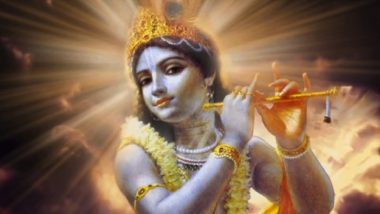The eighth day of the Bhadra month of the Hindu calendar is celebrated as the birth of Lord Krishna, and known as Janmashtami (janma - birth, ashtmi - eighth day). Lord Krishna is an avatar of Lord Vishnu, the protector of the universe. Krishna was born to Vasudeva and Devaki but raised by Nanda and Yashoda. This year Janmashtami is being observed on September 2. The festival is celebrated by decorating homes, worshipping the Balkrishna avatar of Lord Krishna, enjoying the dahi handi sport, singing devotional songs and dance drama (Raas Leela). Each element of Krishna, like his crown, his flute and his swing has a lot of significance in the celebration of the festival and finds a place in the Janmashtami decorations. Janmashtami & Dahi Handi 2018 Date: Confusion Over Whether Festival Is on September 2 or 3; Know Exact Tithi As per Hindu Calendar
A lot of people make the decoration items at homes. Though most of the things are now available in the market, many people prefer making the things at home and indulging in a traditional way of celebrating the festival. We have listed down four simple objects of Lord Krishna - swing, crown, flute and handi and how your can simply make them at home. As a bonus, we have also explained their mythological significance. Here are some simple DIY ideas to decorate your home this Janmashtami. What Is The Significance of Lord Krishna’s Birth in Hinduism and Why Is It Celebrated?
Jhula
Lord Krishna’s idol in his baby form, Balgopal, is placed in a jhula (swing) and worshipped on Krishna Janmashtami. The jhula can be bought in the market or made at home. A lot of people follow the traditional way and make it at home. It is decorated with the elements significant to the Lord. You too can try and make a jhula for Balgopal this year and decorate it easily. And the best part is that these DIY ideas will only require simple materials like thermocol, cardboard, paint, beads and laces that are easily available in any stationary shop.
Significance
Lord Krishna’s swing has symbolic significance. The swing represents human body and soul. The four strings of the swing depict, faith, truth, purity and prayer. The handle on which the swing hangs is symbolic of devotion to the Lord and the devotees’ moving of the swing is supposed to be a force of selfless love for the God. In fact, the Jhulan (swing) festival is dedicated to Lord Krishna. It takes place in the Shravan month, right before Janmashtami and celebrates the love between Lord Krishna and Radha.
Here's a video to tell you how you can make a jhula using the thermocol and cardboard as base and decorate it with items like beads, peacock feathers, decorative strings and laces.
Mukut with Peacock Feather
Lord Krishna's crown (mukut) is integral to Janmashtami. Everyone who dresses as Krishna on this day dons the mukut. It is an important ornament worn by the King of Dwarka, Lord Krishna. He is also known as Mormukatdhari, which can be broken down into - one who wears (dhari) a crown (mukat) like a peacock/with a peacock (mor) feather.
Significance
The peacock feather on the mukut has a story behind it. It is believed that on hearing the tune of Krishna's flute, the peacocks started dancing one day. On their request, Krishna also danced with them and the peacocks in lieu of his greatness offered them their feather and prayed him to wear it as a decoration, to which he obliged.
Watch this video to learn how you can make a traditional mukut for Lord Krishna all by yourself, using simple materials at home.
Bansuri
Bansuri (flute) is revered as the divine musical instrument used by Lord Krishna. It is believed that everyone was spellbound by the melodious music of his flute. It is essential to Lord Krishna's idols and Janmashtami decorations.
Significance
Bansuri is supposed to signify freedom (Pranava). The music of the flute was used by Krishna as a means to convey his love to everyone around him beyond all social barriers of the world. His music attracted everyone alike. Krishna is believed to have made the flute on his own by cutting a bamboo. Another legend says that the Gopis were jealous of the flute for always being with Lord Krishna and asked the flute what is so special about. The flute replied that it is empty, so Krishna can fill it with his melody and attract everyone. This is symbolic of the heart, which should be free of everything, it should be hollow and only then it will be able to give and receive love.
This video teaches three simple ways to make a Bansuri to decorate your Balkrishna at home.
Handi
Lord Krishna's child avatar is revered as a very active and naughty one. He loved eating milk and milk products like butter and yogurt and was often also caught by his adoptive mother Yashoda while doing so. Krishna's love for milk is celebrated in the form of the Dahi Handi sport during Janmashtmi.
Significance
Lord Krishna is lovingly referred to as Makhan Chor (someone who steals butter). Due to his love for butter and habit of stealing and eating it, his mother and other women around kept it in a handi (earthen pot) and hid it somewhere at a height so that Krishna couldn't reach it. But he and his companions were known to form a human pyramid to reach the pot and steal from it. This is believed to be the origin of the dahi handi sport played during Janmashtmi.
Here's how you can make a mini handi at home using simple decorative items like beads and paint.
We hope these methods help you create some wonderful Janmashtmi decorations. Try them at home and share pictures of your creations in the comments section. Happy Janmashtmi.
(The above story first appeared on LatestLY on Aug 27, 2018 06:50 PM IST. For more news and updates on politics, world, sports, entertainment and lifestyle, log on to our website latestly.com).













 Quickly
Quickly


